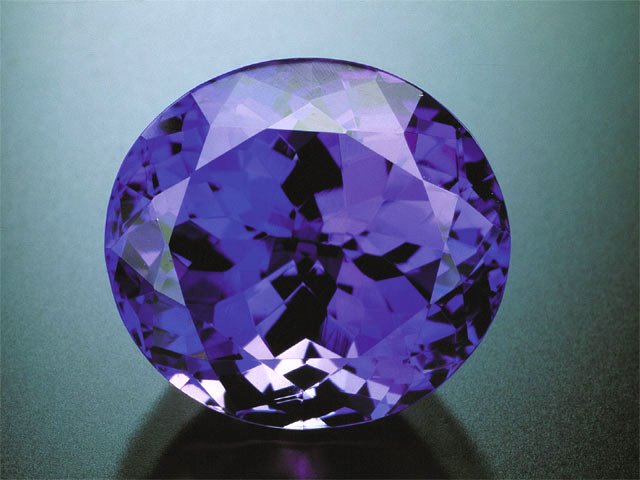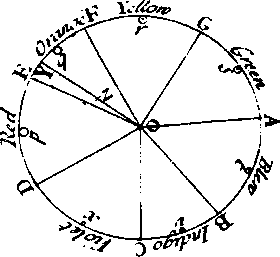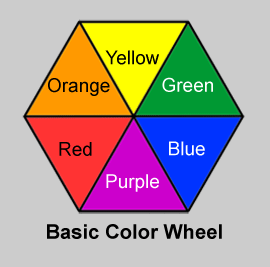
Gem quality tanzanite showing both its primary blue (left) and secondary purple (right) hues. Wise, Richard W., Secrets Of The Gem Trade, p.219
by Richard W. Wise, G.G.
©2011 (revised)
“Roses are red violets are blue but tanzanite ain’t violet.”
In 2007 The Tanzanite Foundation came out with a “standardized” grading system for tanzanite. Shortly later, The American Gem Trade Association’s laboratory adapted this grading system for use on its grading reports. All tanzanite would henceforth be graded on a color scale from violetish blue (vB) to bluish violet ( bV). Great idea, only one problem, they got the colors wrong, they missed purple.
Tanzanite’s primary hue is often blue but never a pure blue. Tanzanite exhibits a secondary hue which is always present. The secondary hue ranges from violet to purple, which though often confused in common speech are distinctly and definably different hues. Violet is a primary spectral hue that lies halfway between purple and blue and Purple is a secondary or modified spectral hue meaning that it results from a mixture of two primary spectral hues (red and blue). That explains why it doesn’t show up when you view the rainbow. Purple is positioned halfway between blue and red. The confusion of violet and purple is not new it goes a long way back but lets begin with Newton. Sir Isac is rightly given credit for initial work in color theory— published in 1706, his was the first color wheel.

The original color wheel courtesy of Sir Isac Newton. In 1708 a Frenchman, Claude Boutet (Traité de la peinture en mignature) added purple.
If you squint (image right) you will see that Newton identified indigo and violet as the two hues existing between blue and red. He either forgot purple or was perhaps pre-purple. Prior to the movement to standardize nomenclature in the 18th Century, colour names, like spelling, were not standardized. Tavernier, for example described the great blue diamond that he sold to Louis XIV as “violet.”
What isn’t generally understood as that Newton’s color wheel was all about opaque colors. Colored light adds a whole new dimension to the color equation.
Using oil paints, mix equal amounts of the two opaque colors red and blue together and the color you get is magenta. Purple can be mixed but painters are reluctant to use the term, preferring blue-violet instead, further adding to the confusion.
“Roses are red, violets are purple sugar is sweet and so is maple surple”
Roger Miller
Change from opaque media to to colored light you dramatically change the result. Mix equal amounts of red and blue light together and you get, guess what, purple.
After tanzanite has been heated, and virtually all tanzanite is heat treated, it is dichroic. That means that light entering the gem crystal divides into two rays each containing a portion of the visible spectrum. The dichroic colors of tanzanite are red and blue—the red is often reddish purple. If the gem is properly oriented before cutting, the face up color will mix the two yielding a range of hues from violetish blue (vB), to purplish blue (pB), to purple-blue (PB) to bluish purple (bP).
Where is the Lab Harmonizing Committee When You Really Need Them?
Studies show that it is particularly difficult for the human eye to distinguish purple, particularly at light tonal levels. This is known as the Bezold-Brücke effect. When purple is present in light-toned gems, the eye wants to see blue. In fact at light tones and low levels of saturation it is difficult to separate purple from violet or even pink. This occurs a lot in light toned topaz. Dealers will often categorize light purple as pink topaz. At darker tonal levels the eye is not bothered by the Bezold-Brücke effect. Yes tanzanite can often be violetish, even blue-violet, but finer stones are purplish-blue so how can purple be left out of the definition?
Traditionally tanzanite has been graded by what I call the “look-alike” standard. When the stone was first discovered, Harry Platt, the Vice President of Tiffanys compared it to sapphire. Platt declared that the finest color of tanzanite was a pure sapphire blue, which means that the finest tanzanite, like sapphire is a medium dark tone (75-80%) slightly violet to purplish blue. A medium dark toned true blue barely exists in nature and only in tanzanite when viewed in noon daylight or daylight fluorescent lighting. Put a “pure” blue tanzanite under the light bulb and a distinct violet to purple secondary hue will always be visible. In the finest stones, a medium dark toned purple adds a velvety richness to the blue, so beautiful that even the folks all the way over at the Tanzanite Foundation, at AGTA and even at GIA should be able to see it.
